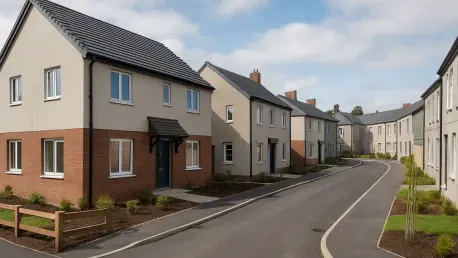We’re thrilled to sit down with Luca Calarailli, a seasoned expert in construction, design, and architecture, whose passion for innovative technology has shaped countless projects in the housing industry. Today, we’re diving into a groundbreaking £42 million deal between Avant Homes South Wales and Valleys to Coast to build 194 affordable homes in Maesteg, Wales. This conversation explores the significance of this regeneration project, the challenges of transforming a former industrial site, the focus on energy efficiency, and the broader impact on the local community. Join us as Luca shares his insights on how this development is set to create a thriving new neighborhood and what it means for the future of affordable housing in the region.
Can you walk us through the vision behind this £42 million partnership between Avant Homes South Wales and Valleys to Coast in Maesteg?
I’m excited to break this down. This deal is all about delivering 194 affordable homes on a 16-acre site that used to be the Ewenny Road Industrial Estate. The vision here is to transform a neglected brownfield area into a vibrant community space. It’s a landmark project for both organizations, being their first collaboration and Avant Homes’ debut in Wales. The goal is to provide high-quality, accessible housing while breathing new life into Maesteg through one of the largest regeneration efforts in the region. It’s a fantastic example of what can happen when local councils, funding bodies, and housing experts come together with a shared purpose.
What makes the former Ewenny Road Industrial Estate a unique choice for this development?
This site has a lot of history as a former industrial estate, and its 16 acres offered a rare opportunity for large-scale redevelopment. It’s strategically located in Maesteg, which desperately needs more housing options. However, being a brownfield site, it came with its share of hurdles—contamination and infrastructure issues, to name a few. Thanks to funding from the Cardiff Capital Region and remediation efforts by Bridgend County Borough Council, those challenges were tackled head-on. Choosing this location wasn’t just about building homes; it was about reclaiming and repurposing land to serve the community in a meaningful way.
Why is this project considered one of the biggest regeneration efforts in the area, and what kind of impact do you foresee for Maesteg?
The scale and ambition of this project really set it apart. We’re not just talking about building houses; we’re creating a whole new community on a site that’s been dormant for years. For Maesteg, this means an influx of affordable housing that can attract families, young professionals, and others who might have struggled to find a place to call home locally. Beyond that, it’s a boost to the local economy, with jobs created during construction and a renewed sense of pride in the area. I expect we’ll see Maesteg evolve into a more dynamic, connected place as this development takes shape.
As this marks Avant Homes South Wales’ first project in Wales, how does it feel to be part of such a milestone, and what does it signify for future growth?
It’s incredibly rewarding to be involved in a project that breaks new ground—literally and figuratively. Entering the Welsh market with a deal of this magnitude shows confidence in the region’s potential and in the strength of partnerships like the one with Valleys to Coast. Their shared commitment to quality and community made them an ideal collaborator. For Avant Homes, this is just the beginning. It signals a strong intent to expand across South Wales, delivering more affordable housing solutions and building on the momentum of this project with other deals already in discussion.
Let’s dive into the homes themselves. With a mix of one-bedroom apartments and larger family houses, how was this variety determined?
The mix—ranging from one-bedroom apartments to two-, three-, and four-bedroom terraced, semi-detached, and detached homes—was carefully planned to meet diverse needs. We looked at the demographics of Maesteg and the surrounding areas to understand who needs housing most. Young singles or couples might gravitate toward the apartments, while families will appreciate the bigger homes with more space. It’s about creating a balanced community where everyone, from first-time renters to growing households, can find something that fits their lifestyle and budget.
Energy efficiency is a major focus, with over half the homes achieving an A rating for energy performance. What drove this emphasis, and how will it benefit residents?
Sustainability is no longer optional; it’s a necessity. With at least 108 homes meeting top-tier Welsh Design Quality Requirements and earning an A rating, we prioritized cutting-edge design to make these homes carbon-free. Think advanced insulation, energy-efficient heating systems, and renewable energy sources where possible. For residents, this translates to lower utility bills and a smaller environmental footprint. It’s about giving people homes that are not only affordable to buy or rent but also affordable to live in long-term, while contributing to broader climate goals.
For the remaining homes with a B rating for energy performance, can you explain the reasoning behind this difference?
Achieving an A rating across all 194 homes would have been ideal, but practical constraints like budget and site-specific challenges meant we had to prioritize. The B-rated homes are still highly efficient compared to older housing stock, and they meet stringent standards for comfort and sustainability. The split allowed us to balance cost with quality. That said, there’s always room to improve, and future upgrades or retrofitting could potentially elevate these ratings as technology and funding become available.
What is your forecast for the future of affordable housing and regeneration projects in regions like South Wales?
I’m optimistic about what lies ahead for areas like South Wales. There’s a growing recognition of the need for affordable housing, and partnerships like this one demonstrate how public and private sectors can collaborate effectively. I foresee more brownfield sites being repurposed as urban areas seek to maximize existing land. Technology will play a bigger role, too—think smarter, greener building methods and materials. The demand for sustainable, community-focused developments will only increase, and I believe South Wales is poised to become a leader in showing how regeneration can transform lives if done thoughtfully.









